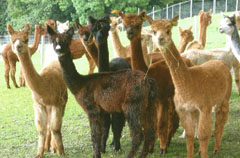Still and quiet alpacas conquer our home
 Horses, cows, sheep, goats - this sight on the pastures is known. But what is it? Again and again we meet pretty farm animals of a different kind: alpacas from the Andes. These lovely immigrants, quietly conquering our homeland, are wool suppliers, breeding animals, therapy helpers and trekking companions.
Horses, cows, sheep, goats - this sight on the pastures is known. But what is it? Again and again we meet pretty farm animals of a different kind: alpacas from the Andes. These lovely immigrants, quietly conquering our homeland, are wool suppliers, breeding animals, therapy helpers and trekking companions.
When you approach a herd of alpacas, they crowd together, stretching their necks askew and oblique, one at a time To catch a glimpse of the fence. But the distance is too small, the caution wins and in no time they whiz away. Alpacas are flight animals. Their confidence can only be won with patience and tact.
The Schur brings valuable wool
The Alpaca Zuchtverband Deutschland eV (AZV) is with over 600 members and Over 12,000 DNA-registered animals are the largest breeding association in mainland Europe. About 7000 years ago, the South American Vicunca, from which today's alpacas emerged, were also domesticated for their dense, warm wool. The alpaca fiber "is one of the most valuable natural fibers in the world", says the AZV. At the annual Schur an alpaca delivers up to 6 kilos of fleece. Depending on the quality, the world market will pay around 15 euros for one kilo of alpaca wool; In Germany, the rare wool can bring more. The fleece can be sold for further processing, as spun wool or finished product (eg sweater, blanket).
High prices in alpaca breeding
Hip is also the alpaca breed. According to breeding farm Sachsen Alpakas (co-founder of the AZVD) costs a DNA-registered female cub from about 3000 euros; pregnant mares are available from 5000 Euro; Top stallions are worth 12,500 euros and more. Tip: The 11th Alpaca-Zuchtschau of the AZVD will take place m 28./29.3.2015 in the Hessenhalle in 36304 Alsfeld.
Put on Alpakas worth
Alpacas are 18 to 20 years old. In the stable, an animal needs about 2 square meters and the stable should be at least 2 meters high, also for the long necks. About 1000 square meters of grazing area are enough for the first two alpacas; for each additional animal 100 sqm are added. There is also enough space for the pasture to be used all year round. The fencing should be 1.00 to 1.30 meters high. Vaccination, deworming, shearing, monthly control and possibly a cut of the toenails are part of the care. It must be remembered that the incisors grow a lifetime and may need to be cut.
Grass, hay and water are the staples of the alpacas. Salt and mineral licks make gourmet happiness perfect. In winter you can also serve concentrated feed. Well-fortified, the animals work as trekking companions in the leisure/tourism sector or as helpers in animal-assisted therapies for, for example, disabled or addicted people. Of course, what is fed in at the top crops up someday. But alpaca owners are even happy about the legacy of their animals, because the feces can be used as fertilizer or sold.
alpacas care for the landscapeThe 425-member association of breeders, keepers and friends of Neuweltkameliden eV in Kaufbeuren also knows many benefits of alpacas: As a callus salmon and because of their feeding behavior, they are used as a soil-conserving landscape care. Anyone who wants to buy alpacas will also get tips and advice from the club in Kaufbeuren, as well as information on the compulsory subject course.
It will take almost one year to give birth
Since 1996, alpacas have been recognized as farm animals in Germany. In other words: they can be slaughtered and would then be suppliers of low-fat and low-cholesterol meat.Especially since not churning new alpacas are born. According to Wikipedia live in Germany just 2000 alpacas. It takes quite a long time until the offspring arrive: the gestation period is around 350 days - almost a year. The baby is nursed for a maximum of eight months and is sexually mature at one to two years. If the newborn weighs 7 to 9 kilos, adult livestock weigh 55 to 65 kilograms. With a height of 75 to 100 cm, the frugal, robust and social alpacas are smaller than llamas. Incidentally, an alpaca does not work, because alpacas need their herd group.
We recommend the book "Lamas and Alpacas" by Gerhard Rappersberger (Ulmer Verlag). Whether descent, acquisition, attitude, care, training, breeding, areas of application, animal welfare law - in the book is a lot in it. Text/Photo: Marion Friedl